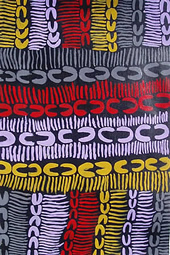
arts
40,000 Year Old Art Tradition Still Drawing Raves
Like many art forms, Aboriginal art is based on dreams and stories, myths and magic, handed down for countless generations. For Aboriginal people, the time before time is known as Dreamtime or the Dreaming, and the whole landscape and all its creatures were the source of inspiration for their art. Rock art documents strange creatures and plants that are no longer on this earth.
Contemporary Aboriginal art builds on this Dreamtime and communicates the artist’s continuing relationship with the land, bringing it to non-indigenous peoples, so they can appreciate this vibrant art. The Dreaming is the story of their ancestors, and the story continues as long as the art continues.
Most notable in the art is the use of iconography that almost appears to be a topographic map – and maybe it is. Dots, totems, concentric circles, curved and straight lines all have specific references. Concentrics, for example, are believed to be campsites, waterholes or significant places.
Kurun Warun (www.kurunwarun.com) first exhibited his art at the age of eight. His art has traditional meaning within its contemporary context. The designs in his paintings have many interrelated symbolic meanings. A dancer as well as a painter, Kurun Warun knows how to use his art to tell a story. Using acrylic and ochre’s,  his work displays an exciting palette of blues, greens, tangerines, silver, copper and gold.
his work displays an exciting palette of blues, greens, tangerines, silver, copper and gold.
Margaret Turner (www.authaboriginalart.com) is a talented artist and educator who has worked at the Irrkelantye Learning Centre. Born out in the bush, she now lives in Alice Springs, and works as an interpreter for government, police, hospital and land council. “I used to see a lot of painting done with my fathers and brothers, that's where I learnt. Paintings I can do is about hunting and teaching young girls about firestick and ochres. The painting I learnt I kept it in my head and I sketch those designs for my children to paint."
The son of an Irish bushman and a Warlpiri mother, Malcolm Jagamarra (www.authaboriginalart.com)  was born in the Australian outback. He lived the traditional way and traveled on walkabout with his mother and family. His mother tried to hide him to prevent the authorities from putting him in the Aboriginal Assimilation Program, but eventually he was taken to Adelaide and not reunited with his family for almost 20 years. He learned the secret songs and dances of his tribe, and his art evolved from the Lander River Warlpiri ceremonies. Aboriginal paintings were originally daubed on the ground and on the bodies of the people and were therefore not preserved until the advent of acrylics on canvas in the 70’s. Since 1971 they have been preserved in the form of acrylic paint on canvas. As Malcom puts it, "Our art reflects not just the land but its mythology, song and dance".
was born in the Australian outback. He lived the traditional way and traveled on walkabout with his mother and family. His mother tried to hide him to prevent the authorities from putting him in the Aboriginal Assimilation Program, but eventually he was taken to Adelaide and not reunited with his family for almost 20 years. He learned the secret songs and dances of his tribe, and his art evolved from the Lander River Warlpiri ceremonies. Aboriginal paintings were originally daubed on the ground and on the bodies of the people and were therefore not preserved until the advent of acrylics on canvas in the 70’s. Since 1971 they have been preserved in the form of acrylic paint on canvas. As Malcom puts it, "Our art reflects not just the land but its mythology, song and dance".
Jay Harrison is a graphic designer and writer whose work can be seen at DesignConcept. He's written a mystery novel, which therefore makes him a pre-published author.
© 2006-2013 ConceptDesign, Inc. Terms of Use
BoomSpeak - For babyboomers - by babyboomers.